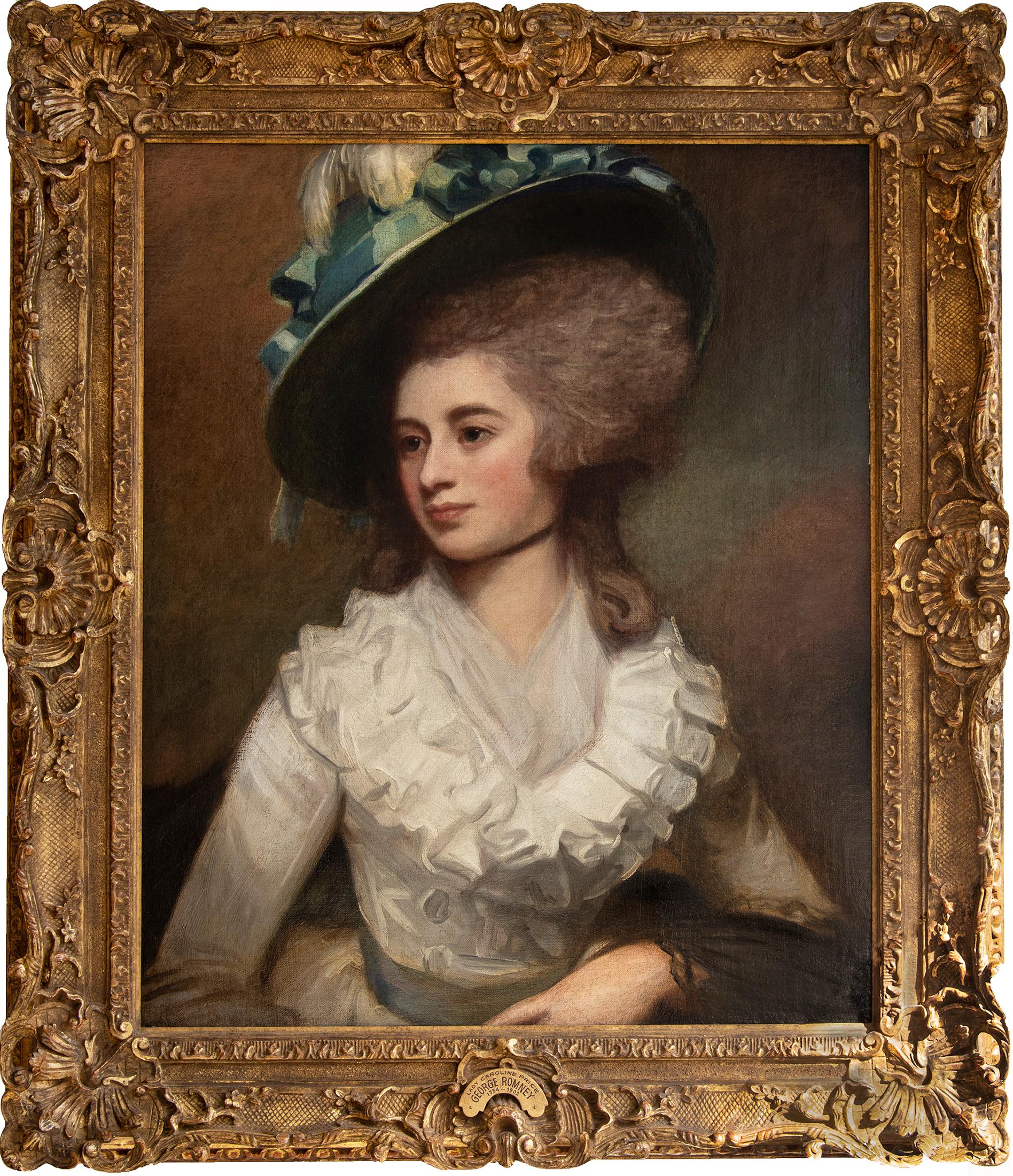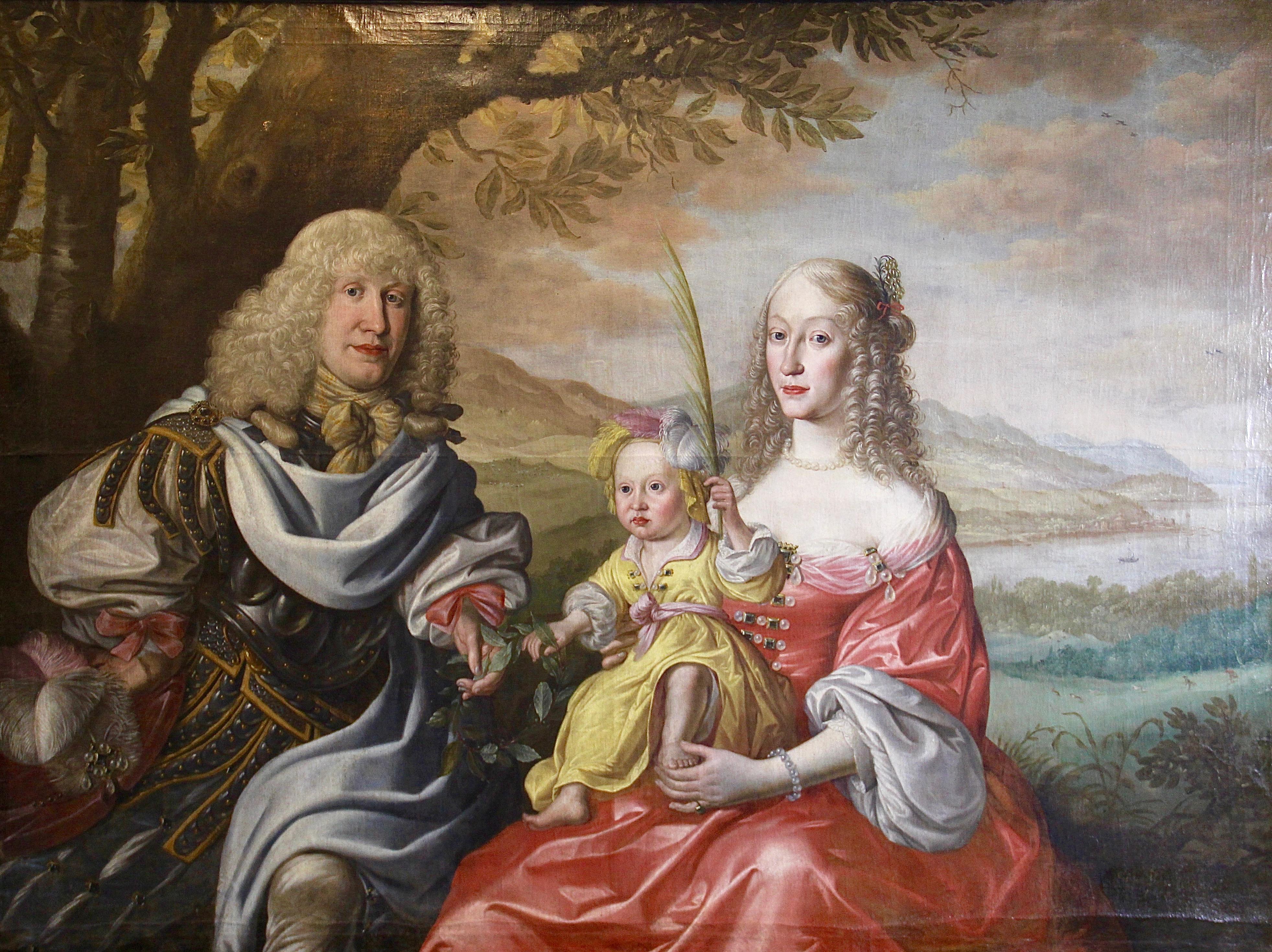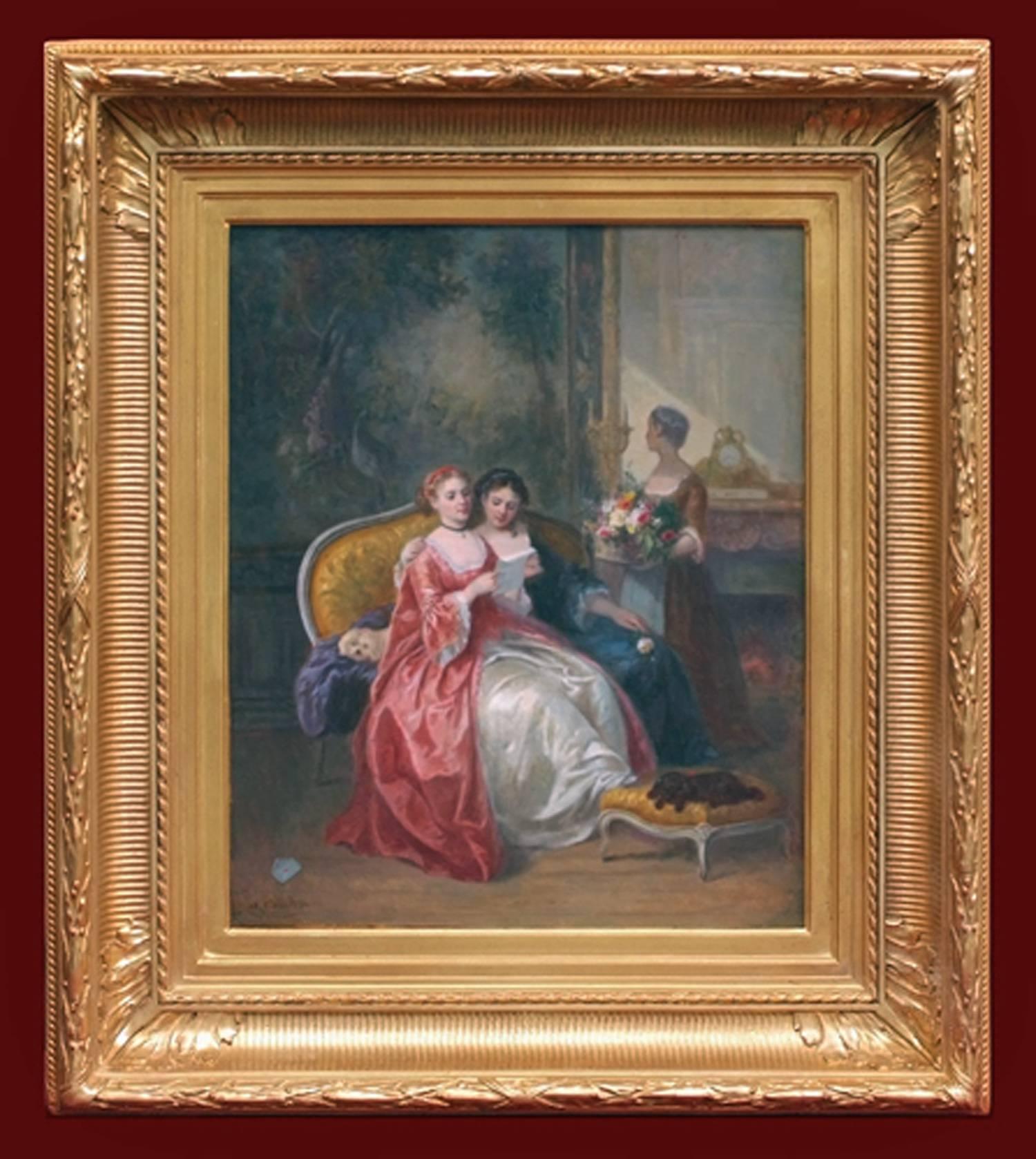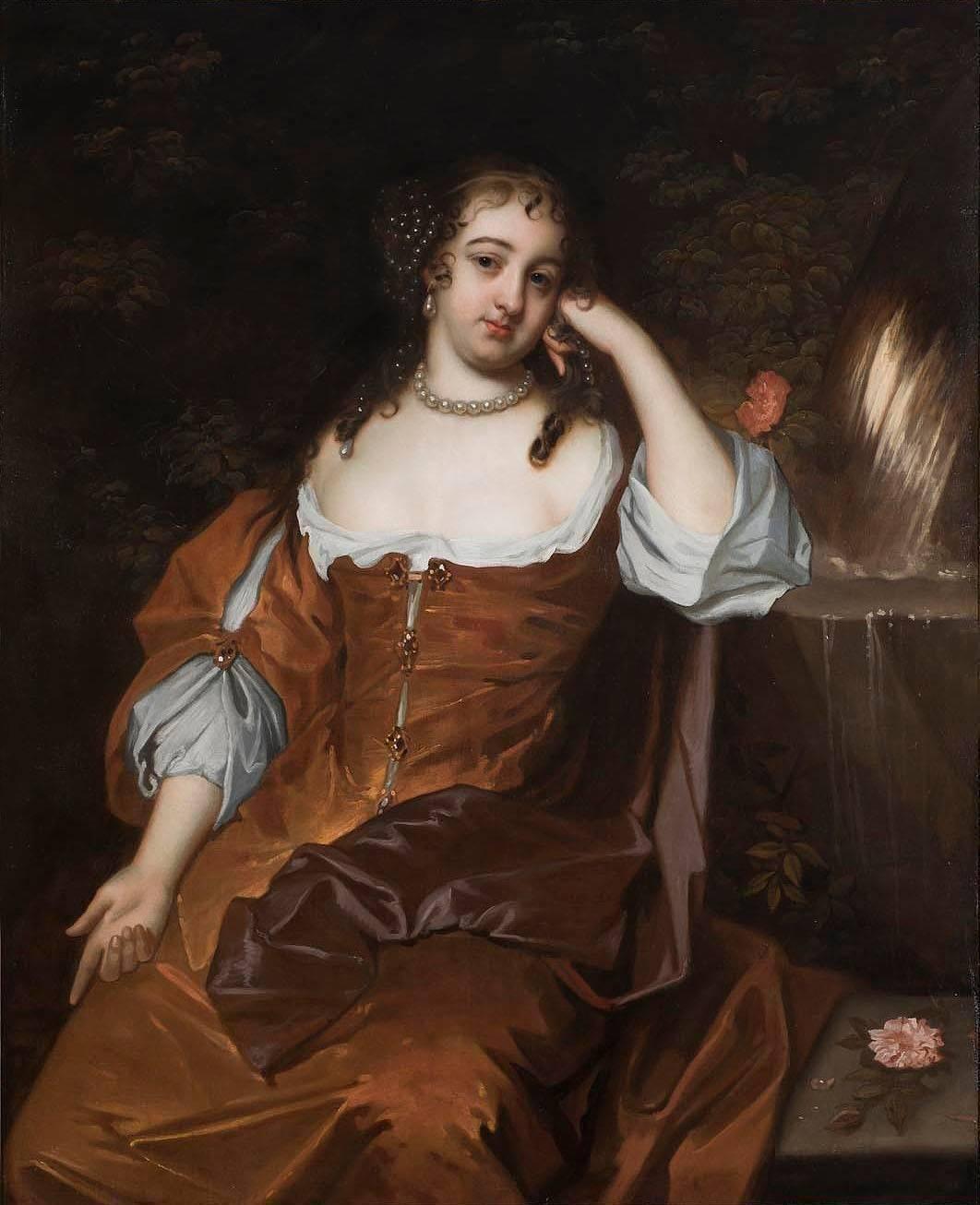Items Similar to 18th Century Oil Painting Portrait of Phillip, 6th Viscount Wenman.
Want more images or videos?
Request additional images or videos from the seller
1 of 8
Nathaniel Dance-Holland18th Century Oil Painting Portrait of Phillip, 6th Viscount Wenman.
About the Item
Sir Nathaniel Dance-Holland (1750-1811) was an English portrait painter and one of the founding members of the Royal Academy in 1768. Justly celebrated in his lifetime he won several important commissions and painted figures as diverse as King George III, Captain James Cook and the renowned actor David Garrick.
After a painting career of great success, in 1790, he gave up art and became a Member of Parliament for East Grinstead in Sussex. He was made a baronet in 1800, which became extinct upon his death in 1811.
This painting depicts Philip Wenman, the sixth Viscount Wenman (1719–1760), a Tory politician.
His notable achievement was being Member of Parliament for the city of Oxford. The Wenman family was closely tied to the High Tory interest which dominated Oxfordshire county politics during the first half of the eighteenth century. Continuing this tradition, Wenman represented the party in the memorably heated election of 1754 between the Tories and the Whigs, who were trying to disrupt the Tory stronghold.
- Creator:Nathaniel Dance-Holland (1735 - 1811, English)
- Dimensions:Height: 47 in (119.38 cm)Width: 37 in (93.98 cm)
- Medium:
- Movement & Style:
- Period:
- Condition:
- Gallery Location:London, GB
- Reference Number:1stDibs: LU67334440231
About the Seller
5.0
Vetted Seller
These experienced sellers undergo a comprehensive evaluation by our team of in-house experts.
Established in 1990
1stDibs seller since 2017
40 sales on 1stDibs
Typical response time: 4 hours
- ShippingRetrieving quote...Ships From: London, United Kingdom
- Return PolicyA return for this item may be initiated within 1 day of delivery.
More From This SellerView All
- 18th C. Portrait of the 4th Earl of Sandwich a View of Constantinople BeyondLocated in London, GBJohn Montagu, 4th Earl of Sandwich (13 November 1718 – 30 April 1792) Attributed to George Knapton (1698-1778) Dressed in the Turkish manner, stand...Category
18th Century Old Masters Figurative Paintings
MaterialsOil
- C19th Portrait Princesse de Joinville of Brazil - Spectacular fit for a palaceBy Henri d'Ainecy MontpezatLocated in London, GBPortrait of Princess de Joinville riding a Bay Horse Henri d’Aincy, Le Comte Monpezat (French 1817-1859) Painted circa 1837-9 oil on canvas 113 x 92 inches (including frame) 92 x 70 inches (unframed) Provenance – from a private royal collection This magnificent portrait depicts Princess de Joinville, the daughter of Pedro I, Emperor of Brazil and the King of Portugal. Through her illustrious family she was directly related Alexander III and Nicholas II of Russia and the Russian royal family, as well as to many of the great ruling families of Europe. The work clearly confirms Monpezat as one of the most accomplished equestrian portrait painters in France in the early nineteenth century. In terms of scale, quality and dramatic power, it must surely be considered amongst his finest works. The stance of the powerful thoroughbred - in half rear - emphasises the calm nature and courage of the Princess. Francisca of Brazil (1824-98) married a son of Louis Philippe I, the King of the French, and had three children. Born at the Imperial Palace of Saint Christopher, her youngest brother was the future Pedro II...Category
1830s Old Masters Portrait Paintings
MaterialsOil
- Lady Dormore - A 16th Century Portrait of a key member of Shakespeare's EnglandLocated in London, GBLady Dormer, Mary Browne c. 1592 oil on panel 35 x 29 inches, unframed; 41 x 34.75 inches, inc. frame Inscribed 'Lady Dormore' Mary married Henry Wriothesley, 2nd Earl of Southampton who gave birth to Henry Wriothesley, 3rd Earl of Southampton - one of the great figures in Shakespears"s circle and founder of the Virginia company, developers of Virginia USA. Henry Wriothesley, born 6 October 1573 at Cowdray House, Sussex, was the only son of Henry Wriothesley, 2nd Earl of Southampton, by Mary Browne, the only daughter of Anthony Browne, 1st Viscount Montague, and his first wife, Jane Radcliffe.[5] He had two sisters, Jane, who died before 1573, and Mary (c. 1567 – 1607), who in June 1585 married Thomas Arundell, 1st Baron Arundell of Wardour.[6] After his father's death, Southampton's mother married firstly, on 2 May 1595, as his second wife, Sir Thomas Heneage (d. 17 October 1595), Vice-Chamberlain of the Household, and secondly, between 5 November 1598 and 31 January 1599, Sir William Hervey. She died in November 1607.[7] Early life When his father died on 4 October 1581 Southampton inherited the earldom and landed income valued at £1097 6s per annum. His wardship and marriage were sold by the Queen to her kinsman, Charles, Lord Howard of Effingham, for £1000. According to Akrigg, Howard then "entered into some further agreement, of which no documentation can now be found, which transferred to Lord Burghley personally the custody and marriage of the young Earl, but left Howard holding his lands", and late in 1581 or early in 1582 Southampton, then eight years of age, came to live at Cecil House in the Strand.[8] In October 1585, at age twelve, Southampton entered St John's College, Cambridge,[9] graduating M.A. on 6 June 1589.[10] His name was entered at the Gray's Inn legal society before he left the university, and he was admitted on 29 February 1588.[11] On Southampton's 16th birthday, 6 October 1589, Lord Burghley noted Southampton's age in his diary, and by 1590 Burghley was negotiating with Southampton's grandfather, Anthony Browne, 1st Viscount Montague, and Southampton's mother, Mary, for a marriage between Southampton and Lord Burghley's eldest granddaughter, Elizabeth Vere, daughter of Burghley's daughter, Anne Cecil, and Edward de Vere...Category
16th Century Old Masters Figurative Paintings
MaterialsOil
- 17th Century Oil Painting Portrait of a Young English BoyBy Gerard SoestLocated in London, GBGerard SOEST (1600 - 1681) Portrait of a Young Boy oil on canvas 35.5 x 30.5 inches inc. frame Gerard Soest (circa 1600 – 11 February 1681), also known as Gerald Soest, was a portra...Category
17th Century Old Masters Portrait Paintings
MaterialsOil
- Stunning 17th Century Oil Painting - Study of a Head of a ManBy Anthony van DyckLocated in London, GBStudio of Sir Anthony Van Dyck (1599-1641, Flemish) Study of a Head of Man Circa 1627-32, Van Dyck’s second Antwerp period Oil on paper, laid down on canvas Dimensions 15 x 14 inches...Category
17th Century Old Masters Portrait Paintings
MaterialsOil
- 16th Century Italian Renaissance Old Master Portrait of a ProcuratoreBy Jacopo BassanoLocated in London, GBJacopo BASSANO (c. 1510-1592, Italian) Portrait of a Procuratore Oil on canvas 30 ¼ x 26 inches (including frame) Provenance: Lucien Bonaparte’s Collection (as Portrait of Doge Priuli, Tiziano); Rich-mond, Virginia Museum, Portrait of Doge Lorenzo Priuli. The painting is a portrait of a man half-length, on a black background. It is a three-quarter portrait, according to a custom very common in the genre of portraiture in sixteenth century. The man is wearing a decorated...Category
16th Century Old Masters Portrait Paintings
MaterialsOil
You May Also Like
- Portrait of Gentleman, Thomas Bruce, Earl of Elgin c.1638 Manor House ProvenanceLocated in London, GBTitan Fine Art present this picture which formed part of a historic collection of an English aristocratic family, Lord and Lady Sandys at their magnificent baroque and Regency Grade-I listed family home, Ombersley Court. The house was among the most fascinating survivals of its kind in this country. The atmospheric interiors were distinguished above all for the works of art associated with two key moments in national history and, more specifically, to the roles of Colonel the Hon. John Russell in the Civil War and the reign of King Charles II and of Lord Arthur Hill, later 2nd Baron Sandys, in the Peninsular War. The collection was acquired or commissioned over five centuries and remained at Ombersley Court until its recent sale, the first in 294 years. This painting hung in The Great Hall (see photo). This charming portrait is an example of the type of small-scale panel portraits, often of splendid beauties of the time, that became fashionable from about the first quarter of the seventeenth century. The sitter has been depicted wearing a low-cut silk dress with the wide billowing sleeves typical of the late 1630’s. The simplicity of the ensemble is reinforced by the absence of lace on either the collar or cuffs. At this time gone are the complicated layers of fabrics, and now replaced with understated elegance of plain silk (satin and taffeta were most popular), with only a couple of focal points as accessories. There is an abundance of the accessory par excellence – pearls, and they are worn as a necklace, on her attire, and as earrings; the pear-shaped earrings are called ‘unions excellence’ reflecting the difficulty of finding perfectly matched pearls of such large size. They could range up to 20 millimetres in diameter. There is a splendid display of gold, diamond and pearl jewellery which is an obvious sign of her wealth. The portrait is thought to represent Thomas Bruce (1596-1654), Earl of Elgin. The physiognomy and features in our portrait strongly correlate to a portrait of the Earl, by Cornelius Johnson (1593-1661), painted circa 1638, and is held at Kenwood House, London. Another painting from Ombersley Court, also with Titan Fine Art, is contemporaneous to ours and is thought to represent the Earl’s wife, Diana Cecil, 1st Countess of Elgin (c.1603-1654) - it appears to have derived from Cornelius Johnson’s depiction of the Countess circa 1638, also at Kenwood House. During the 1630’s Johnson painted a number of portraits, obviously influenced by Van Dyke. Here, Theodore Russel, who worked in the studios of both Van Dyle and Johnson, and later specialised in small scale reproductions of his master’s works, modelled the head, with the striking large dark eyes, on Cornelius Johnson, and the attire on Anthony van Dyke. There are also other portraits by Johnson of the sitter with very similar facial features to that of the sitter in ours. Theodore Russel and Cornelius Johnson also had a family connection as it is thought that Russel’s step-mother was a sister of Johnson. Thomas Bruce, 1st Earl of Elgin, was a prominent Scottish nobleman who held titles such as the 3rd Lord Bruce of Kinloss. He resided at Houghton House in Bedfordshire and played a significant role in the political and social landscape of his time. His legacy as an Earl and Lord continues to be remembered in history. Thomas Bruce, born in Edinburgh in 1599, inherited the Scottish peerage title as the 3rd Lord Bruce of Kinloss at the age of 13 following his brother's untimely death in a duel. The family's estates, including Whorlton Castle and manor, were granted by King James I of England to Thomas's father, with the wardship of Thomas and the estates entrusted to his mother until he reached the age of 21. He maintained a strong connection with King Charles I's court during the Personal Rule, receiving titles of honour and prestigious roles throughout the years. Thomas Bruce was married twice in his lifetime. His first marriage was to Anne Chichester in 1622. Ann died in 1627, the day after giving birth to their only child, Robert Bruce, who later became the 1st Earl of Ailesbury. On 12 November 1629, Thomas Bruce married Lady Diana Cecil, the daughter of William Cecil and widow of Henry de Vere. The marriage was childless, but Diana brought significant estates with her. Thomas Bruce died on 21 December 1663 at the age of 64. This oil on panel portrait has been well cared for over its life, which spans almost four centuries. Having recently undergone a treatment to remove an obscuring discoloured varnish, it can be fully appreciated, and attributed to Theodore Russel. Once owned by Evesham Abbey, the manor of Ombersley was acquired by the Sandys family in the early 1600s, when Sir Samuel Sandys, the eldest son of Edwin Sandys, Bishop of Worcester and later Archbishop of York, took a lease on the manor, before receiving an outright grant in 1614. The present house, Ombersley Court, dates from the time of Samuel, 1st Lord Sandys, between 1723 and 1730. The house itself is a fine example of an English Georgian country house set in rolling countryside and surrounded by Wellingtonias, planted to commemorate the Battle of Waterloo by Arthur Hill, 2nd Baron Sandys, who played a distinguished part in the battle and was one of the Duke of Wellington’s aides de camp. The Duke also stayed in the house and in the Great Hall, was the Waterloo banner which was brought to the house by Sir Arthur Hill, aide-de-camp to the Duke of Wellington, who succeeded his mother, the Marchioness of Downshire as 2nd Lord Sandys. Further Waterloo memorabilia are kettle drums from battle. The family had a strong tradition of military and political service, dating back to the 17th century, and this was also reflected in the fine collection of portraits and paintings in the house. In short, Ombersley represented a vital aspect of British history. The house and more especially the collection were of the greatest historical importance. Houses that have remained in the possession of the same family for as many as three centuries have become increasingly rare. Through this portrait, collectors have a chance to acquire a piece of British history and an evocative vestige of a glittering way of life, which is now gone. Presented in a fine period frame. Theodore Russell, or Roussel, was born in London in 1614. His father came from Bruges to England and was the Royal Stuart jeweller. His apprenticeship was spent in the studio of his uncle, Cornelius Johnson, with whom he lived for about nine years. Sometime after 1632, he is said to have worked as an assistance to Van Dyck. He executed numerous copies of portraits by his famous master and other notable painters, also painting original works. He is particularly remembered for his portraits of Charles II at Woburn Abbey and James II at the Palace of Holyrood. His son, Antony Russel (c.1663–1743) was also a portrait-painter and is said to have studied under John Riley. Several of his copies were in the Royal Collections, and among the nobility. Provenance Richard Hill...Category
17th Century Old Masters Portrait Paintings
MaterialsOil, Wood Panel
- Portrait of a Lady Diana Cecil, Countess of Elgin c.1638, Manor House ProvenanceLocated in London, GBTitan Fine Art present this picture which formed part of a historic collection of an English aristocratic family, Lord and Lady Sandys at their magnificent baroque and Regency Grade-I listed family home, Ombersley Court. The house was among the most fascinating survivals of its kind in this country. The atmospheric interiors were distinguished above all for the works of art associated with two key moments in national history and, more specifically, to the roles of Colonel the Hon. John Russell in the Civil War and the reign of King Charles II and of Lord Arthur Hill, later 2nd Baron Sandys, in the Peninsular War. The collection was acquired or commissioned over five centuries and remained at Ombersley Court until its recent sale, the first in 294 years. This painting hung in The Great Hall (see photo). This charming portrait is an example of the type of small-scale panel portraits, often of splendid beauties of the time, that became fashionable from about the first quarter of the seventeenth century. The sitter has been depicted wearing a low-cut silk dress with the wide billowing sleeves typical of the late 1630’s. The simplicity of the ensemble is reinforced by the absence of lace on either the collar or cuffs. At this fashion moved away from complicated layers of fabrics to an understated elegance of plain silk (satin and taffeta were most popular) with only a couple of focal points as accessories. However, obligatory for any respectable woman, pears are shown in abundance, as a necklace, on the dress attire, and pear-shaped earrings called ‘unions excellence’ reflecting the difficulty of finding perfectly matched pearls of such large size. They could range up to 20 millimetres in diameter. There is a splendid display of gold, diamond and pearl jewellery which is an obvious sign of her wealth. The subject is thought to be Diana Bruce née Cecil, 1st Countess of Elgin (c.1603-1654). The physiognomy and features strongly correlate to a portrait of the countess by Cornelius Johnson (1593-1661), painted circa 1638, at Kenwood House, London. Another painting from Ombersley Court, also with Titan Fine Art, is contemporaneous to this and is thought to represent the countess’s husband, Thomas Bruce, 1st Earl of Elgin (1599-1663) – it appears to have derived from Cornelius Johnson’s portrait of the Earl, of circa 1638, also at Kenwood House. During the 1630’s Johnson painted a number of portraits, obviously influenced by Van Dyke. Here, Theodore Russel, who worked in the studios of both Van Dyle and Johnson, and later specialised in small scale reproductions of his master’s works, appears to have modelled the head, with the striking large dark eyes, on Cornelius Johnson, and the attire on Anthony van Dyke. Theodore Russel and Cornelius Johnson also had a family connection as it is thought that Russel’s step-mother was a sister of Johnson. Diana Cecil, Countess of Oxford (1596–1654), later Countess of Elgin, was an English aristocrat. She was probably the middle daughter of the three daughters of William Cecil, 2nd Earl of Exeter and Elizabeth Drury. Her first husband, Henry de Vere, 18th Earl of Oxford, died in battle only 18 months after their marriage in 1624. She married her second husband Thomas Bruce (1599-I663) in 1629, becoming the Countess of Elgin in 1633. Her portrait was presumably painted at a similar time as the companion portrait of her husband, the Earl of Elgin. She died in 1654, outlived by her husband and leaving no children. A large monument exists of the countess in her burial shroud at Ailesbury Mausoleum, Bedfordshire. The work has been well cared for over its life, which spanning almost four centuries, and having recently undergone a treatment to remove an obscuring discoloured varnish, it can be fully appreciated, and attributed to Theodore Russel. Once owned by Evesham Abbey, the manor of Ombersley was acquired by the Sandys family in the early 1600s, when Sir Samuel Sandys, the eldest son of Edwin Sandys, Bishop of Worcester and later Archbishop of York, took a lease on the manor, before receiving an outright grant in 1614. The present house, Ombersley Court, dates from the time of Samuel, 1st Lord Sandys, between 1723 and 1730. The house itself is a fine example of an English Georgian country house set in rolling countryside and surrounded by Wellingtonias, planted to commemorate the Battle of Waterloo by Arthur Hill, 2nd Baron Sandys, who played a distinguished part in the battle and was one of the Duke of Wellington’s aides de camp. The Duke also stayed in the house and in the Great Hall, was the Waterloo banner which was brought to the house by Sir Arthur Hill, aide-de-camp to the Duke of Wellington, who succeeded his mother, the Marchioness of Downshire as 2nd Lord Sandys. Further Waterloo memorabilia are kettle drums from battle. The family had a strong tradition of military and political service, dating back to the 17th century, and this was also reflected in the fine collection of portraits and paintings in the house. In short, Ombersley represented a vital aspect of British history. The house and more especially the collection were of the greatest historical importance. Houses that have remained in the possession of the same family for as many as three centuries have become increasingly rare. Through this portrait, collectors have a chance to acquire a piece of British history and an evocative vestige of a glittering way of life, which is now gone. Presented in a fine period frame. Theodore Russell, or Roussel, was born in London in 1614. His father came from Bruges to England and was the Royal Stuart jeweller. His apprenticeship was spent in the studio of his uncle, Cornelius Johnson, with whom he lived for about nine years. Sometime after 1632, he is said to have worked as an assistance to Van Dyck. He executed numerous copies of portraits by his famous master and other notable painters, also painting original works. He is particularly remembered for his portraits of Charles II at Woburn Abbey and James II at the Palace of Holyrood. His son, Antony Russel (c.1663–1743) was also a portrait-painter and is said to have studied under John Riley. Several of his copies were in the Royal Collections, and among the nobility. Provenance Richard Hill...Category
17th Century Old Masters Portrait Paintings
MaterialsOil, Wood Panel
- Portrait of Lady Caroline PriceBy George RomneyLocated in Miami, FLDESCRIPTION: Perhaps the best Romney in private hands. If Vogue Magazine existed in the late 18th century, this image of Lady Caroline Price would be ...Category
1970s Old Masters Portrait Paintings
MaterialsCanvas, Oil
- SIMON PETER TILEMANN, Family Portrait, 1658, Old Master. Baroque Rococo PaintingBy Simon Peter TilemannLocated in Berlin, DEExtremely decorative and large oil painting from the 17th century. Restored in places. Signed and dated Simon Peter Tileman 1658 fecit 'lower right Dimensions without frame. From Wikipedia, the free encyclopedia: Simon Peter Tilemann (1601, Lemgo – 1668, Vienna), was a German Baroque painter who was active Bremen, Kassel and Italy. According to Houbraken he first learned to paint flowers and he had a daughter who could paint flowers in watercolors. He was a good landscape painter who spent many years in Italy, but later switched to portrait painting and who painted the portrait of Ferdinand...Category
1650s Old Masters Portrait Paintings
MaterialsCanvas, Oil
- 19th Century Painting Interior and Genre SceneBy Jean Alexandre Rémy CouderLocated in Saint-Ouen, FRCOUDER Alexandre Jean Rémy (1808-1879) Reading on the sofa Oil on canvas signed low left Old original frame gilded with leaves Dim canvas : 47 X 39 cm Di...Category
1860s Old Masters Interior Paintings
MaterialsOil
- Portrait of a Lady, 17th Century Flemish Oil Old MastersBy Jacob HuysmansLocated in London, GBJacob Huysmans Flemish 1633 - 1696 Portrait of a Lady Oil on canvas Image size: 49 x 40 ¼ inches Gilt frame Huysmans was born in Antwerp and came to England during the reign of Charles II where he became one of the fashionable painters of the court.. The diarist Samual Pepys noted the artist as capable of a more exact likeness than Lely. Certainly the diarist records that by August 1664 in the circle of Queen Catherine...Category
17th Century Old Masters Portrait Paintings
MaterialsCanvas, Oil, Acrylic
Recently Viewed
View AllMore Ways To Browse
18th Century Oil
Portrait Of Actor
Antique Dance
18th Oil Painting
Portrait Of An Actor
Eighteenth Century Art
18th Century English Painting
English Portraits 18th
Dance Of Death
6th Century
Late 18th Century Dutch
English 18th Century Portrait Paintings
Dance Party
James Dutch
18th Century Dutch Paintings
Oil Painting 1800
James Holland
18th Century Painting Dutch





